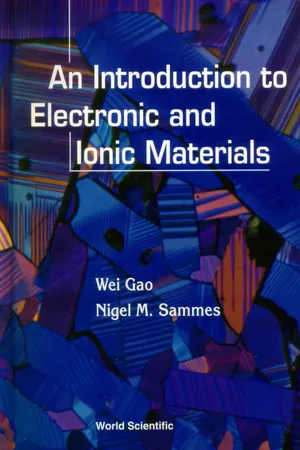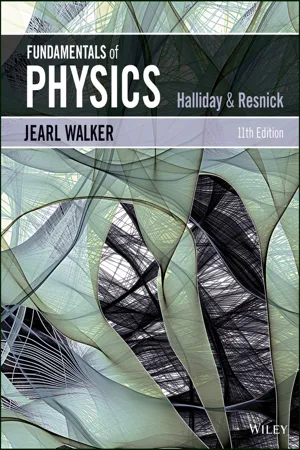Physics
Conductance
Conductance refers to the measure of a material's ability to conduct electric current. It is the reciprocal of resistance and is represented by the symbol G. Conductance is influenced by factors such as the material's composition, temperature, and dimensions, and is an important concept in understanding the flow of electricity in various systems.
Written by Perlego with AI-assistance
Related key terms
1 of 5
7 Key excerpts on "Conductance"
- eBook - PDF
- William Moebs, Samuel J. Ling, Jeff Sanny(Authors)
- 2016(Publication Date)
- Openstax(Publisher)
All such devices create a potential difference and are referred to as voltage sources. When a voltage source is connected to a conductor, it applies a potential difference V that creates an electrical field. The electrical field, in turn, exerts force on free charges, causing current. The amount of current depends not only on the magnitude of the voltage, but also on the characteristics of the material that the current is flowing through. The material can resist the flow of the charges, and the measure of how much a material resists the flow of charges is known as the resistivity. This resistivity is crudely analogous to the friction between two materials that resists motion. Resistivity When a voltage is applied to a conductor, an electrical field E → is created, and charges in the conductor feel a force due to the electrical field. The current density J → that results depends on the electrical field and the properties of the material. This dependence can be very complex. In some materials, including metals at a given temperature, the current density is approximately proportional to the electrical field. In these cases, the current density can be modeled as J → = σ E → , where σ is the electrical conductivity. The electrical conductivity is analogous to thermal conductivity and is a measure of a material’s ability to conduct or transmit electricity. Conductors have a higher electrical conductivity than insulators. Since the electrical conductivity is σ = J /E , the units are σ = [J ] [E] = A/m 2 V/m = A V · m . Here, we define a unit named the ohm with the Greek symbol uppercase omega, Ω . The unit is named after Georg Simon Ohm, whom we will discuss later in this chapter. The Ω is used to avoid confusion with the number 0. One ohm equals one volt per amp: 1 Ω = 1 V/A . The units of electrical conductivity are therefore ( Ω · m) −1 . Conductivity is an intrinsic property of a material. - eBook - PDF
- Keith Oldham, Jan Myland(Authors)
- 2012(Publication Date)
- Academic Press(Publisher)
1 The Conduction of Electricity At the heart of electrochemistry lies the coupling of chemical changes to the passage of electricity. It is therefore appropriate to begin our study of electrochemical science by reviewing some fundamental concepts of electricity and the ways in which it passes through materials. 1:1 Electric charge and electric current When studied in elementary physics, electricity is often treated as if it were a fluid which is able to flow through some substances, those that are called electrical conductors, but is unable to pass through other substances, which are known as insulators. We refer to a specific quantity of this fluid as an electric charge or an amount of electricity. The symbol Q is used to represent electric charge; it is measured in coulombs. Imagine electricity flowing through a conductor of uniform cross section, such as the cylinder shown below. If the charge dQ crosses the plane at χ = 0 in the time interval dt, we say that there is an electric current / flowing with magnitude dQ/dt, I ι 2 1 The Conduction of Electricity The unit of current is the ampere, equal to one coulomb per second. Another important quantity is current density. When a current / flows across, and at right angles to, a surface of area A, there is said to be a current density i equal to the quotient of / and A 1:1:2 and measured in amperes per square metre. Looking upon electricity as a fluid, one finds that it behaves almost incompressibly; that is, like a liquid rather than a gas. Thus, like water in a pipe, if the current / is flowing across the χ = 0 plane of the conductor, then the same current / is flowing across every other parallel plane, such as the second shaded disc shown below. Moreover, the identical current / must also be passing in to and out of the conductor along the wires, though the current densities in these wires will be much greater than that in the cylindrical conductor. - eBook - PDF
Lessons From Nanoelectronics: A New Perspective On Transport (Second Edition) - Part A: Basic Concepts
A New Perspective on Transport(In 2 Parts)
- Supriyo Datta(Author)
- 2017(Publication Date)
- World Scientific(Publisher)
It is well-known that the conductivity varies widely, changing by a factor of ∼ 10 20 going from copper to glass, to mention two materials that are near two ends of the spectrum. But this is not because one has more electrons than the other. The total number of electrons is of the same order of magnitude for all materials from copper to glass. Whether a material is a good or a bad conductor is determined by the availability of states in an energy window ∼ kT around the electrochemical potential μ 0 , which can vary widely from one material to another. This is well-known to experts and comes mathematically from the dependence of the conductivity on -∂f 0 ∂E rather than f 0 ( E ) a result that typically requires advanced treatments based on the Boltz-mann equation (Chapter 9 ) or the fluctuation-dissipation theorem (Chap-ter 5 ). 2.5.2 Present approach We obtain this result in an elementary way as we have just seen. Current is driven by the difference in the “agenda” of the two contacts which for low bias is proportional to the derivative of the equilibrium Fermi function: f 1 ( E ) -f 2 ( E ) ≈ -∂f 0 ∂E qV. There is no need to invoke mysterious forces that stops some electrons from moving, though one could perhaps call it a mysterious force, since the Fermi function (Eq. ( 2.2 )) reflects the exclusion principle. Later when we (briefly) discuss phonon transport in Chapter 14 , we will see how this approach is readily extended to describe the flow of phonons. The phonon current is governed by the Bose (not Fermi) function which is appropriate for particles that do not have an exclusion principle. Chapter 3 The Elastic Resistor Related video lectures available at course website, Unit 1: L1.3 and L1.4 . We saw in the last chapter that the flow of electrons is driven by the dif-ference in the “agenda” of the two contacts as reflected in their respective Fermi functions, f 1 (E) and f 2 (E). - Wei Gao, Nigel M Sammes;;;(Authors)
- 1999(Publication Date)
- WSPC(Publisher)
Resistivity (p). The resistance of a specimen with unit length and unit cross-sectional area. Conductivity (a). The reciprocal of resistivity, 1/p. Ohm's law. The current density is proportional to the conductivity and electric field J = aE. Drift velocity of an electron, (vd). The average velocity of an electron. Electron mobility (/JL). The drift velocity of an electron in a unit field. Relaxation time (r). The average time between collisions of the conduction electrons with phonons, lattice defects, etc. Mean free path (7 m ). The average distance travelled by an electron between two collisions. Classical Theory of Electrical Conduction and Conducting Materials 33 Residual resistivity, (p). The temperature-independent part of the resistiv-ity of a conductor. Defects and impurities are responsible for the residual resistivity. Thermal resistivity, (pr). The part of the resistivity caused by tempera-ture. Thermal resistivity caused by the vibration of the positive ion-cores about their equilibrium positions. TCR. Temperature coefficient of resistivity. Matthiessen's rule. The total resistivity of a conductor is the sum of a temperature-dependent component, pr, and a temperature-independent component, p r . Hall effect. When a magnetic induction B is imposed perpendicular to the flow of current J, a voltage perpendicular to both B and J appears. This phenomenon is called the Hall effect and the voltage is called the Hall voltage. Nordheim's Rule. Expressed as p.(x) = Ax(l— x), where x is the concentra-tion of a given impurity and p r (x) is the contribution due to the impurity. A is a constant that depends on the impurity and the conductor. Resistivity ratio. The ratio of the resistivity at room temperature (298 K) to the resistivity at 4 K. Resistivity ratio is approximately P29s/Pr-Wiedemann-Franz law. The ratio of the electrical conductivity to the ther-mal conductivity of a metal at a constant temperature is a constant.- eBook - PDF
- David Halliday, Robert Resnick, Jearl Walker(Authors)
- 2021(Publication Date)
- Wiley(Publisher)
A given material obeys Ohm’s law if its resistivity, defined by Eq. 26.3.3, is independent of the magnitude and direction of the applied electric field E → . Resistivity of a Metal By assuming that the conduction electrons in a metal are free to move like the molecules of a gas, it is possible to derive an expression for the resistivity of a metal: ρ = m _____ e 2 nτ . (26.4.5) Here n is the number of free electrons per unit volume and τ is the mean time between the collisions of an electron with the atoms of the metal. We can explain why metals obey Ohm’s law by pointing out that τ is essentially independent of the magni- tude E of any electric field applied to a metal. Power The power P, or rate of energy transfer, in an electrical device across which a potential difference V is maintained is P = iV (rate of electrical energy transfer). (26.5.2) Resistive Dissipation If the device is a resistor, we can write Eq. 26.5.2 as P = i 2 R = V 2 ___ R (resistive dissipation). (26.5.3, 26.5.4) In a resistor, electric potential energy is converted to internal thermal energy via collisions between charge carriers and atoms. Semiconductors Semiconductors are materials that have few conduction electrons but can become conductors when they are doped with other atoms that contribute charge carriers. Superconductors Superconductors are materials that lose all electrical resistance at low temperatures. Some materials are superconducting at surprisingly high temperatures. 1 Figure 26.1 shows cross sections through three long conduc- tors of the same length and material, with square cross sections of edge lengths as shown. Conductor B fits snugly within con- ductor A, and conductor C fits snugly within conductor B. Rank the following according to their end-to-end resistances, greatest first: the individual conductors and the combinations of A + B (B inside A), B + C (C inside B), and A + B + C (B inside A inside C). - David Halliday, Robert Resnick, Jearl Walker(Authors)
- 2023(Publication Date)
- Wiley(Publisher)
Drift Speed of the Charge Carriers When an electric field E → is established in a conductor, the charge carriers (assumed posi- tive) acquire a drift speed v d in the direction of E → ; the velocity v → d is related to the current density by J → = (ne) v → d , (26.2.4) where ne is the carrier charge density. Questions 769 Resistance of a Conductor The resistance R of a conductor is defined as R = V __ i (definition of R), (26.3.1) where V is the potential difference across the conductor and i is the current. The SI unit of resistance is the ohm (Ω): 1 Ω = 1 V/A. Similar equations define the resistivity and conductivity σ of a material: ρ = 1 __ σ = E __ J (definitions of and σ), (26.3.5, 26.3.3) where E is the magnitude of the applied electric field. The SI unit of resistivity is the ohm-meter (Ω · m). Equation 26.3.3 cor- responds to the vector equation E → = ρ J → . (26.3.4) The resistance R of a conducting wire of length L and uni- form cross section is R = ρ L __ A , (26.3.9) where A is the cross-sectional area. Change of ρ with Temperature The resistivity for most materials changes with temperature. For many materials, including metals, the relation between and temperature T is approximated by the equation – 0 = 0 α(T – T 0 ). (26.3.10) Here T 0 is a reference temperature, 0 is the resistivity at T 0 , and α is the temperature coefficient of resistivity for the material. Ohm’s Law A given device (conductor, resistor, or any other electrical device) obeys Ohm’s law if its resistance R, defined by Eq. 26.3.1 as V/i, is independent of the applied potential dif- ference V. A given material obeys Ohm’s law if its resistivity, defined by Eq. 26.3.3, is independent of the magnitude and direction of the applied electric field E → . Resistivity of a Metal By assuming that the conduction elec- trons in a metal are free to move like the molecules of a gas, it is possible to derive an expression for the resistivity of a metal: ρ = m _____ e 2 nτ .- eBook - PDF
- David Halliday, Robert Resnick, Jearl Walker(Authors)
- 2018(Publication Date)
- Wiley(Publisher)
One explanation for superconductivity is that the electrons that make up the current move in coordinated pairs. One of the electrons in a pair may electrically distort the molecular structure of the superconducting material as it moves through, creating nearby a short-lived concentration of positive charge. The other electron in the pair may then be attracted toward this positive charge. According to the theory, such coordination between electrons would prevent them from colliding with the molecules of the material and thus would eliminate electrical resistance. The theory worked well to explain the pre-1986, lower temperature superconductors, but new theories appear to be needed for the newer, higher temperature superconductors. 763 REVIEW & SUMMARY 0.16 0.08 0 0 2 4 6 Temperature (K) Resistance ( ) Ω Figure 26-14 The resistance of mercury drops to zero at a temperature of about 4 K. Courtesy Shoji Tonaka/International Superconductivity Technology Center, Tokyo, Japan A disk-shaped magnet is levitated above a superconducting material that has been cooled by liquid nitrogen. The goldfish is along for the ride. Current An electric current i in a conductor is defined by i = dq dt . (26-1) Here dq is the amount of (positive) charge that passes in time dt through a hypothetical surface that cuts across the conductor. By convention, the direction of electric current is taken as the direc- tion in which positive charge carriers would move. The SI unit of electric current is the ampere (A): 1 A = 1 C/s. Current Density Current (a scalar) is related to current density J → (a vector) by i = ∫ J → · dA → , (26-4) where dA → is a vector perpendicular to a surface element of area dA and the integral is taken over any surface cutting across the conduc- tor. J → has the same direction as the velocity of the moving charges if they are positive and the opposite direction if they are negative.
Index pages curate the most relevant extracts from our library of academic textbooks. They’ve been created using an in-house natural language model (NLM), each adding context and meaning to key research topics.






